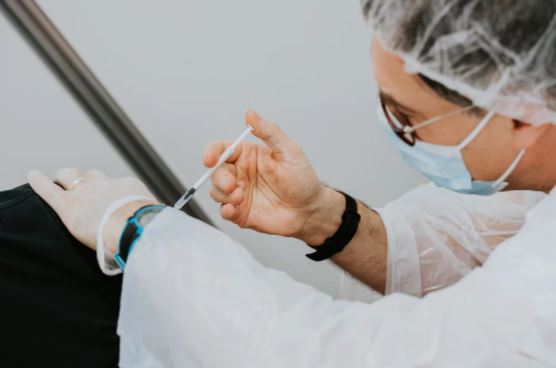Dec 3 (PTI) – Scientists have found a possible trigger behind the extremely rare blood clots linked to AstraZeneca and Johnson & Johnson COVID-19 vaccines, an advance that may help design new and improved preventives against the viral disease.
An international team of researchers investigated vaccine-induced immune thrombotic thrombocytopenia (VITT), also known as thrombosis with thrombocytopenia syndrome (TTS), a life-threatening condition seen in a very small number of people after receiving the adenovirus vaccines.
Subscribe to our Telegram channel for the latest updates from around the world
“The mechanism which results in this condition, termed vaccine-induced immune thrombotic thrombocytopenia (VITT), was unknown,” said corresponding author of the study Abhishek Singharoy, from Arizona State University, US.
The researchers at Arizona and Cardiff University in the UK worked with AstraZeneca to analyse whether the ultra-rare side effect could be linked to the viral vector which is used in many vaccines, including those from Oxford/AstraZeneca and Johnson & Johnson.
The findings, published in the journal Science Advances, suggest it is the viral vector — in this case, an adenovirus used to shuttle the coronavirus’ genetic material into cells — and the way it binds to platelet factor 4 (PF4) once injected that could be the potential mechanism.
In very rare cases, the scientists suggest, the viral vector may enter the bloodstream and bind to PF4, where the immune system then views this complex as foreign.
READ: India defers plan to resume international flights from Dec 15
They believe this misplaced immunity could result in the release of antibodies against PF4, which bind to and activate platelets, causing them to cluster together and triggering blood clots in a very small number of people after the vaccine is administered.
Professor Alan Parker, from Cardiff University’s School of Medicine, said VITT only happens in extremely rare cases because a chain of complex events needs to take place to trigger this ultra-rare side effect.
“Our data confirms PF4 can bind to adenoviruses, an important step in unravelling the mechanism underlying VITT. Establishing a mechanism could help to prevent and treat this disorder,” Parker said.
“We hope our findings can be used to better understand the rare side effects of these new vaccines — and potentially to design new and improved vaccines to turn the tide on this global pandemic,” he added.
READ: Pfizer is already working on Covid vaccine targeting Omicron variant: Pfizer CEO
Both the AstraZeneca and Johnson & Johnson vaccines use an adenovirus to carry spike proteins from the coronavirus into people to trigger a protective immune response.
When both vaccines showed the ultra-rare side effect of VITT, scientists wondered whether the viral vector had some part to play.
Another important clue was that neither the Moderna nor Pfizer vaccines, made from an entirely different technology called mRNA vaccines, showed this effect.
The team used cryo-EM technology to flash-freeze preparations of ChAdOx1, the adenovirus used in the AstraZeneca vaccine and bombard them with electrons to produce microscopic images of the vaccine components.
READ: ‘Don’t freak out’ about Omicron, says BioNTech CEO
They were then able to look in atomic level at the structure of the outer protein cage of the virus — the viral capsid — and other critical proteins that allow entry of the virus into the cell.
The researchers outlined the details for the structure and receptor of ChAdOx1, which is adapted from chimpanzee adenovirus Y25 — and how it interacts with PF4.
They believe it is this specific interaction — and how it is then presented to the immune system — that could prompt the body’s own defences to view it as foreign and release of antibodies against this self-protein.
The team also used the computational models to show that one of the ways the two molecules tightly bind is via electrostatic interactions.
READ: WHO advises unvaccinated senior citizens to postpone travel
The group showed that ChAdOx1 is mostly electronegative.
This makes the protein act like the negative end of a battery terminal, and could attract other positively charged molecules to its surface.
“We found that ChAdOx1 has a strong negative charge. This means the viral vector can act like a magnet and attract proteins with the opposite, positive charge, like PF4,” said study first author Alexander Baker.
“We then found that PF4 is just the right size and shape that when it gets close to ChAdOx1 it could bind in between the negatively charged parts of ChAdOx1’s surface, called hexons,” Baker said.
READ: Why WHO chose to skip ‘Nu’ and ‘Xi’ and named new COVID-19 variant as Omicron
The team is hopeful that armed with a better understanding of what may be causing rare VITT they can provide further insights into how vaccines and other therapies, which rely on the same technology, might be altered in the development of the next generation vaccines and therapies.
“With a better understanding of the mechanism by which PF4 and adenoviruses interact there is an opportunity to engineer the shell of the vaccine, the capsid, to prevent this interaction with PF4,” said Baker.
“Modifying ChAdOx1 to reduce the negative charge may reduce the chance of causing thrombosis with thrombocytopenia syndrome,” he added.
For similar articles, join our Telegram channel for the latest updates. – click here



























































